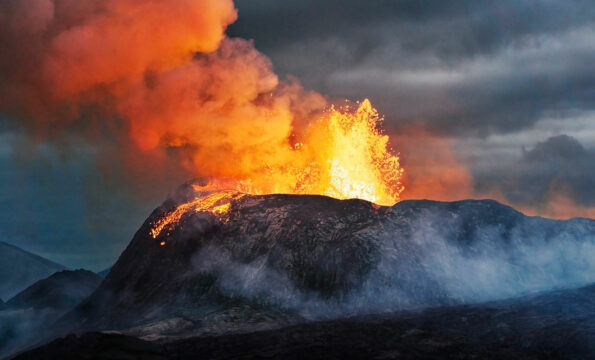Live Science, by Hannah Osborne: Another volcanic eruption could take place in Iceland in a matter of days or weeks, authorities have warned.
According to experts with the Icelandic Met Office (IMO), 230 million cubic feet (6.5 million cubic meters) of magma has now entered the chamber sitting beneath Svartsengi, around 2.5 miles (4 kilometers) north of the town of Grindavík — meaning the volume is fast approaching levels seen before the eruption on Jan. 14, when two fissures opened on the outskirts of the town.
According to a translated statement from the IMO, the volume of magma in the chamber will reach the same level seen in the last eruption within the next two weeks.
Unlike the previous eruptions, the warning time this time could be as little as one hour due to fewer earthquakes in the build-up, IMO representatives wrote. “In case of repeated magma flows, it is likely that the path for the magma will be easier and this will be accompanied by less seismic activity,” they wrote in the statement.
Benedikt Ófeigsson, head of deformation measurements at the IMO, told Iceland’s national broadcaster RUV that the most likely place a fissure will appear is between Stóra-skógafell and Hagafell — 3.7 miles and 1.2 miles (5.9 km and 2 km), respectively, northeast of Grindavík.
“It is not likely that it will erupt inside the town and in fact the geological data does not indicate that, but nothing is out of the question so we have to keep it in as a possibility, ” he said. “Maybe it’s time for magma not to get this far south again. However, we do not have any measurements that tell us when enough is enough, so we have to assume that the magma can go south again in the direction of Grindavík.”
A 9.3 mile (15 km) magma dike — a near-vertical tunnel running from the magma chamber beneath — formed beneath the Reykjanes Peninsula in October and November last year. It erupted on Dec. 18, with a wall of lava flowing from a 2.5-mile (4 km) fissure.
After a period of quiet, the volcano erupted again on Jan. 14, when two fissures opened up just north of Grindavík. Lava flows from the smaller eruption entered the town and destroyed houses. Since then, the land around Svartsengi has continued to rise, indicating magma is still accumulating beneath the surface and that this wave of volcanic activity is not over.
It’s not possible to predict exactly where an eruption could take place. Carmen Solana, associate professor of volcanology and risk communication at the University of Portsmouth in the U.K., previously told Live Science that magma will rise to the surface through the weakest points in Earth’s crust. “We don’t know where the next one is going to happen and we don’t know how large it will be,” she said. “That’s the sad part of volcanology — we know that something is going to happen and you know roughly where, but you cannot pinpoint with that precision.”
An updated hazard map from the IMO shows the region running north-northwest of Grindavík appears to be at greatest risk from a fissure opening without notice. The town of Grindavík is considered to be at “considerable risk,” with lava flows and land collapse possible.
Prophetic Link:
“At this time immense forests were buried. These have since been changed to coal, forming the extensive coal beds that now exist, and also yielding large quantities of oil. The coal and oil frequently ignite and burn beneath the surface of the earth. Thus rocks are heated, limestone is burned, and iron ore melted. The action of the water upon the lime adds fury to the intense heat, and causes earthquakes, volcanoes, and fiery issues. As the fire and water come in contact with ledges of rock and ore, there are heavy explosions underground, which sound like muffled thunder. The air is hot and suffocating. Volcanic eruptions follow; and these often failing to give sufficient vent to the heated elements, the earth itself is convulsed, the ground heaves and swells like the waves of the sea, great fissures appear, and sometimes cities, villages, and burning mountains are swallowed up. These wonderful manifestations will be more and more frequent and terrible just before the second coming of Christ and the end of the world, as signs of its speedy destruction.” Patriarchs and Prophets, 108.2






Comments